Rebecca Ashton at a clinic with German Master Dressage trainer, Jonny Hilberath. Rebecca also took the photos of the clinic..
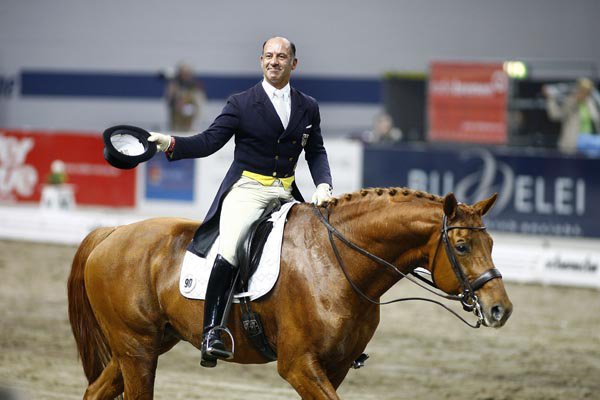
Share German dressage coach Jonny Hilberath’s ideas and approaches. Jonny’s approach was simple and horse friendly, asking for tactful and sensitive riding.
“It’s a special and exciting thing to do because it’s a lifetime sport. Every day there is something new.”
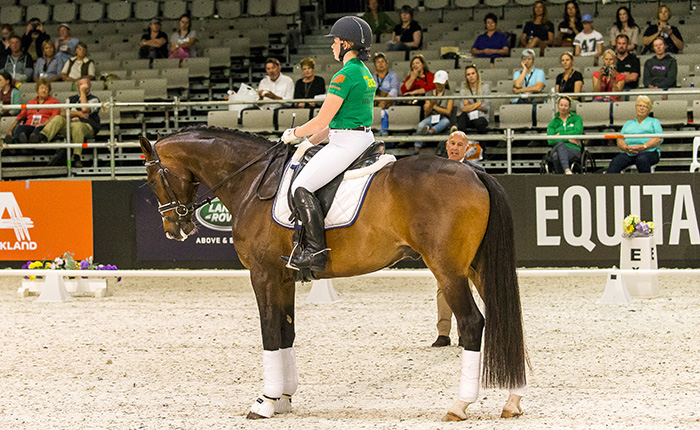
The first rider in the arena was Grace Farrell on her eight-year-old, Vollrath Luigi.
Jonny asked Grace to start with a halt in the middle of the arena so the audience could get an idea of what a good, young dressage horse looks like.
“Get him loose and warm. Make sure every day it is long enough that the horse feels good under the saddle, good in the back, good in the contact so you can ride the horse’s neck and mouth independent so he doesn’t lose rhythm or balance.
“He has good, basic elasticity. Watch the hind legs, they are also very nice. ride just a bit more forward with more ‘schwüng’ to improve the horse’s balance. Now the tail swings more and the hind leg comes more off the ground, and the shoulder freer.”
Jonny also pointed out that when Grace rode the horse more forward, the contact got quieter.
Next the horse was offered a walk break before the canter work began. While the pair were walking on a loose rein, Jonny emphasised the importance of breaks, “…..we often override the horses either because it’s so much fun, or because we have something in our mind that we want better, and we forget the horse is just tired. You can’t make enough breaks. You pick up the reins after a break and things go easier.”
Jonny on the importance of the walk: “I walk 15-20 minutes before the first trot step – people didn’t use it enough. You can do some exercises in walk before you do the first trot. In the competition arena, also remember the walk has a coefficient of 2. You can make marks with the walk, like this horse has a great walk, but it has to be ridden and regular.”
next Jonny works on canter
“Work so his back and joints get more life in them. You can improve the gaits of any horse. They may not trot for an 8 or a 9, but the elasticity and length of the stride can be improved.”
Grace then showed us the progression to the start of lateral work with some shoulder in and travers. The increased difficulty meant the trot got a little slower and the horse’s head slightly too low, so Jonny instructed Grace to pick the horse’s head up and ask for more positivity to keep the quality of the work. Grace complied as Jonny acknowledged, “Good. It’s a different dynamic now. He comes more out of the shoulder and there is more freedom and hence more quality. Keep the flexion into the direction to which you move.”
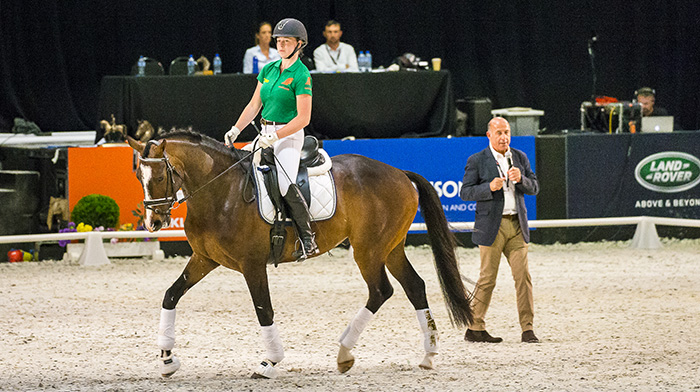
The final exercise was an extended trot over the diagonal accompanied by the instruction, “Try to make him more up first and then ride forward into the extension.” Luigi then stayed safer in rhythm and there was more freedom of expression, which was rewarded with a stretchy trot to finish.

Next was NZ Young Rider Champion Amy Sage on RM All About Me.
As Grace had shown us the preparation work, it was straight into half passes. Jonny explained that horses need to be positive enough, so that we can ride with small details, and present them well. Amy had also asked to work on getting more expression in the trot. “This horse is a typical mare, it’s a little long in the back, and the back is a little lower and a little more restricted in the shoulder, so this is what we have to work on as a rider. So, start half pass then change into shoulder in and use the shoulder in to get the neck more up to correct the position.” Amy did it only a couple of times before a walk break.
Jonny continued, “I do this exercise a lot at home to get the horse rather elastic in the back and also sensitive to your aids, which will over time produce elasticity in the work. Make transitions in the lateral work and in the tempo to improve the quality of self carriage.”
The first exercise in canter was travers on the long side. Jonny focused on the rider, “Sit a little more upward to open the front of your body a bit. This also helps get the horse’s neck up. If you sit too much forward, there is more weight on the horse’s front end. So basically you collect yourself together with the horse.”
The travers then evolved into half passes and the consistency of head position. “Pick both sides of her head up and get the backside of the horse more under the body.”
Jonny gave the pair a different exercise, counter canter on a 20m circle, to get the quality of the canter better, and to help the horse improve her balance explaining, “Over time this makes quite a difference to the horse’s balance and improves self carriage and lightness.
“Now to the left. You can see the horse struggles a little bit more in the left canter. So the horse needs more help from her with the right rein. Now the horse starts to look shorter. This is how we teach collection.”
As the pair had a walk break, Jonny continued, “If we want to ride dressage sport, we need to ride with energy under the saddle, but control it. The worst you can do is fight with the horse. You need to understand how to make the horse work with the energy. It was interesting with that counter canter, because you could see how the body changed, but also the mind. You need to get into a tunnel with horse where you have answer, question, answer, question, and not stress.”
Kiwi rider Andrea Bank, who was based at Jonny’s stable in Germany for over two years was on the sideline asking her trainer to expand on ideas, and explain further about bringing the horse’s head up:
“You must explain it to the horse. This horse, she cannot help it, is a little flat by nature. You can try to explain to the horse about its own body by just simply and gently taking your arms up once, just to show her the way when she hides her neck a little bit. We just have to set goals for ourselves, goals in relation to the quality. That looks better Amy, and with not so much effort. The horse is fresh, positive and light to the leg.”
Jonny really wanted the audience to understand the importance of making the work simple. The horse does things without knowing it’s doing them, because it’s easy for them. This is why we use the movements to get the improvements instead of fighting with the horse.
We saw a couple of other higher movements before the end of the session, and the basic message kept returning to the same point, QUALITY. “Her flying changes are very straight and good rhythm but to get more points, the horse could carry itself up a little more. There could have been more quality. This is what every rider should have in their mind; not to ride and ride and ride with no change in the horse. Have goals in relation to quality.”
When Amy played with some pirouettes, “Less leg. Let your legs hang more. If the horse gets over tense and locks its body, get her up a little more and unlock the door and that unlocks her back and then you need less leg.”
The session finished with stretching and Jonny insistent that the horse learns to hold itself and to build it’s own muscles for support.
another rider comes next
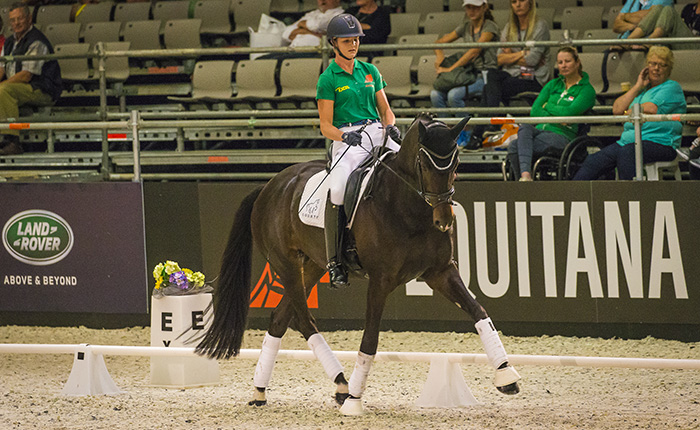
Chanel Flyger and level five horse Hot Chocolate MH have been together for one year and Jonny began explaining his first impressions as the pair trotted around, “She’s very light on her legs and shows an expressive picture. She’s a bit thoroughbred in her movement, so we work on more cadence. Trot with a little bit more energy so she gets more power in her hind legs.”
After a walk break Jonny wanted to look at extension in the trot. It wasn’t about a whole diagonal with full extension, but just forward and back around the arena, “Not for too far, more on, off, on, off. Don’t let your arm get too high. If the reins are too high, we lose our horse, and they don’t swing anymore to our hand, and the horse runs underneath our contact. She must be correctly on the bit for the transition. The top line should lift.”
After a few more tries, “You can see, compared to the first trot, the shoulder is more free. When you get more energy into the body, the gaits get completely different.
“Now combine that trot with shoulder in. Try to have your hands at the same level inside and outside rein. Keep the trot that you had before. They can get shy, especially if they are not used to going with such tempo. Like us, they get a bit insecure when you first take them out of their comfort zone, but dare to try.”
“Don’t fall asleep in between. When you think half halt, don’t think of your hand, get a bit more upright in your body. Be careful with your hands, if they get too strong the horse slows down. It’s actually unpleasant for the horse.”
“Tell us what you think Chanel, because I think that it isn’t bad.” Chanel replied, “It feels awesome!” and Jonny agreed, “It was much more fresh and much better self carriage. When you think uphill, don’t think it comes from the hand, think it comes from behind.”
Andrea was again on hand to get Jonny to expand, on having the horse in front of the leg, recalling how in Germany Jonny had explained that it wasn’t just having the horse in front of your leg, but also in front of your seat, so its legs weren’t moving under a dead body.
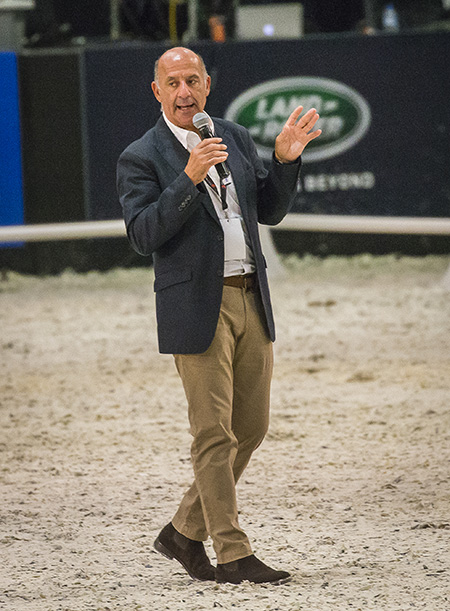
“If the horse is on our hand and we just start to push with our leg, it will get heavier. First you have to get the horse off your hand and more in self carriage, then you ride it forward.”
The movements developed with working canter pirouettes next on the agenda. Jonny was impressed, “You can see the hind legs come more under. When the horse gets tense, just massage the mouth gently, not so the neck goes down, but that it just comes together, but keep her up. Collection is not a question of tempo, but elasticity. Don’t slow down.”
“Now just trot to feel if there is a difference. Look at the end of the tail, it’s swinging left, right, left, right.” Hot Chocolate had done enough so it was time to stretch and finish.
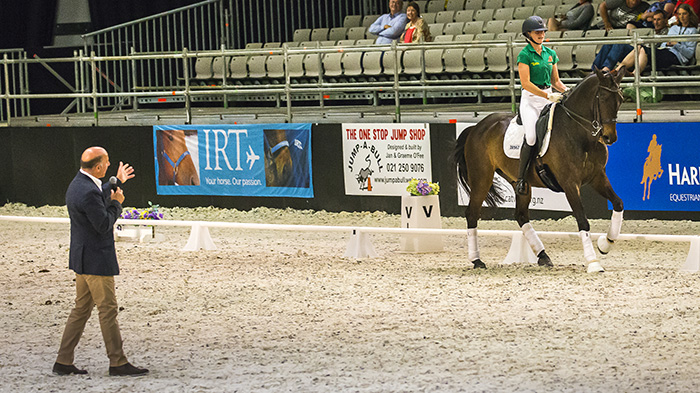
Sixteen-year-old Alcatraz and Nikita Osborne were next, the pair having trained to Grand Prix. “She is my guinea pig to show the connection between small tour and big tour. Inter A and Inter B…few steps piaffe and passage and a few tempis.”
As Nikita got her horse used to the arena, Jonny told us how the elasticity and strong beat Alcatraz showed in the trot, made it easier for the rider to get the horse in balance and rhythm.
The trot developed to forward and back into a few steps of baby passage, “Just be careful you don’t lose the correct rhythm when you bring him back, less hand. We have to be very, very careful with the rhythm. If you work too long with irregularity, it can become a bad habit. You should correct it by going forward, not collecting more.”
“Have the feeling you would like air under his neck. Don’t let him get heavy and hold that weight, because he’ll slow down. You instead want to give him freedom. Getting energy means to bring the horse more in front.”
“Nikita you ride a little too backward when you come to passage. You want elasticity and cadence, more energy. Then the horse gets more confidence. When you ride too slow, the horse falls apart and the hind leg falls out behind.” Nikita was working on getting Alcatraz more through his back, and focusing on increasing the energy, rather than bringing the horse backwards to create the passage, and the expression got better.
“Regularity and rhythm have to go through all the collected work as well. If the horse gets heavy, use the energy more. If you remember this rule, it will stop you making mistakes even if you are not as experienced as a rider. Keep going back to the basics.”
Nikita then showed us some piaffe, “We have a little bit again the problem we had in passage, the horse isn’t completely regular in the hind leg. So, walk to get the neck a little more up, not shorter, and get the horse straighter. You have to remember, to have the horse more up, the neck cannot get shorter as this is a problem in the back.”
Jonny brought them back to walk. “If the horse isn’t completely regular, it’s uncoordinated and insecure, so get them back on four legs and get them secure. Give him the feeling of the body again.”
“Try again and dare to have the neck much more free. Then stop, get the hind leg a little more under. Forward, then rein back to get the hind leg a little more under again. It’s all playing.”
After a break it was into the canter work and Nikita started with some two tempis. Jonny helped when it was time to start the ones, “Don’t ride too fast. Connection is not speed. One/One to start the ones.”
Nikita had the horse bouncing along beautifully, but Jonny wanted just a touch more self carriage and more straightness to the left.
Nikita was getting the hang of things and did a fabulous long side of tempis but then, instead of leaving it, she had another go and her focus wavered. Jonny roused on her with a big smile, “That was a super, super example of how not to do it! It was too fast and unprepared. The canter was totally lost and then you waste time and energy in the horse. It takes a lot of energy from the horse, and that is not endless.” Again, there was that message, do less, but with more quality.
Another go, “Sometimes Nikita twists the shoulders too much and then she’s not fast enough in her aids. You need more contact on the left. This is very good to see how you correct these problems though.”
“Wonderful. Let him stretch out. Thank you for showing us these difficulties. We can all enjoy good riding, good tests, but the daily training, we all have problems to solve.” Amen to that!
more to come
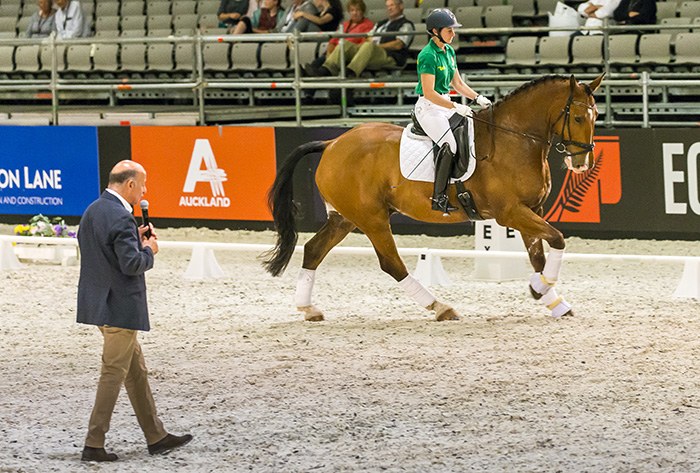
Carolyn McCree was on her 13-year-old Grand Prix ride, Antipodes, who has a good dose of Percheron/Clydesdale in his mix. “Now we have something very, very interesting. He is a real heavyweight. Look at his hind leg. He has natural power, but that can create a little bit of trouble and it can bring weight to the reins.”
“Let’s start with the basics, the transitions where the horse has to react and respond, which gets him more in the tunnel. Trot, when he gets too strong, take him back again to sit him until you can ride without a big effort.”
“Carolyn, you have to ride the trot, not hold the trot. Let him work through the back and get more loose through his body. Change tempo. That is the key. Do something with his energy. And halt. Pat him. All this is communication.”
“This needs time. It all needs time. When you have a hot horse, you need time to settle him in. Let him trot more through the back. Get him a bit more in the flow. Also the contact from the mouth to the hand could be more steady, so you need to produce that through the swinging of his back.”
Jonny then wanted to see the transitions to passage, bringing attention to the straightness of the horse’s neck and mouth. “Ja. And trot away. It also helps for sure to get the horse’s attention. Much better.” Jonny continued to explain how when the horse was bent too much, the regularity of the hindleg was lost slightly, but when Carolyn was able to straighten him up, the regularity improved. “Now the horse is happier and calmer, physically and mentally.”
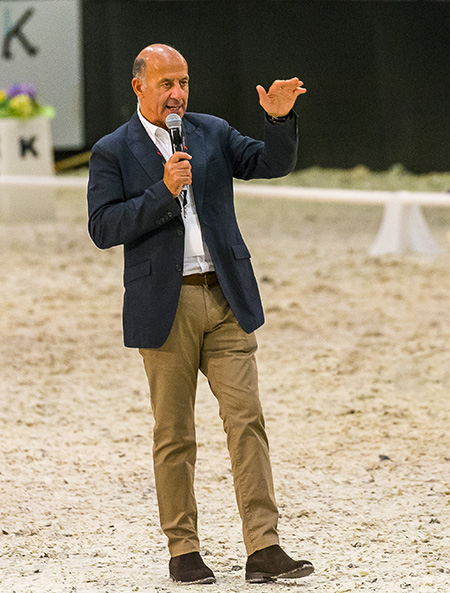
Andrea was back on the mike asking Jonny to explain the use of the seat in the half halt.
“We have to use our seat differently. If the horse is very forward thinking, we definitely don’t put too much pressure in the seat. We just get him more under. If slower, use more back so the horse understands that the energy has to stay in front. It depends on the energy the horse offers me.”
After a walk break, Carolyn was into the canter with Jonny explaining that with so many coefficients in the Grand Prix canter work, the movements were a very important focus.
Carolyn worked on the collection of the canter before pirouettes. “A little bit more flexion. Keep your inside hand a little higher and stay still with the hand. Much better. If the hand’s too active, it is difficult for your horse to hear your seat and leg. Get the canter correct first, don’t let him get behind you. Good, now make the pirouette simple and easy, pat him in the pirouette.”
Patting the horse during the movements was such a good take away, big show environments can be scary so that little bit of reassurance works a treat.
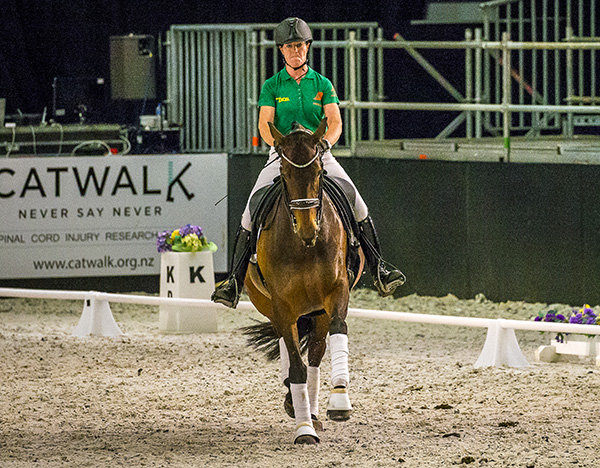
Victoria Wall and Letty Lei
Victoria Wall was on her 10-year-old Letty Lei and Jonny liked the mare’s light and electric way of going straight from the start, “I like that type; where you can get yourself as a rider a little bit backwards, and let the horse come out in front which makes it very nice and easy if you find the button for control. I like it when you can’t hear the horse on the ground. It is very balanced and in self carriage and has a well connected hind leg which is good for the lateral work. It is a good example of a modern dressage horse.”
The session was to focus on getting more expression and elasticity into the trot work and piaffe/passage. “Start with the horse responding to your aids and through. Feel the quality of the contact on the left and the right is the same. A little more forward; a little more fresh. Very good.”
Victoria worked on more energy in the trot so that it could be used in the passage, but Jonny was insistent that it came more from the seat and that a light contact was maintained. When Victoria began the passage work, Letty Lei dropped behind her aids a bit. “That stops the passage, your hands are too high and the horse can no longer find the connection from the back to the front, and can no longer find the natural way to balance itself. We don’t have to be strong with the spurs. We use the transitions then the horse gets better self carriage. This is a simple and stressless way to train the horse.”
An extension across the diagonal was used to refresh the trot before going back to the passage. Jonny still wanted things a little different, “I think your feeling is not quite right. You are coming back to do passage, but the horse has to be in front of your hand and bouncing off the ground. Make it in a playful way. Use a little bit the stick on the backside. Create more energy, but not more stress. Give her more possibilities with her neck. If the strength from the back meets your stronger hand, the energy clashes in the back and stomach and she cannot swing forward anymore.”
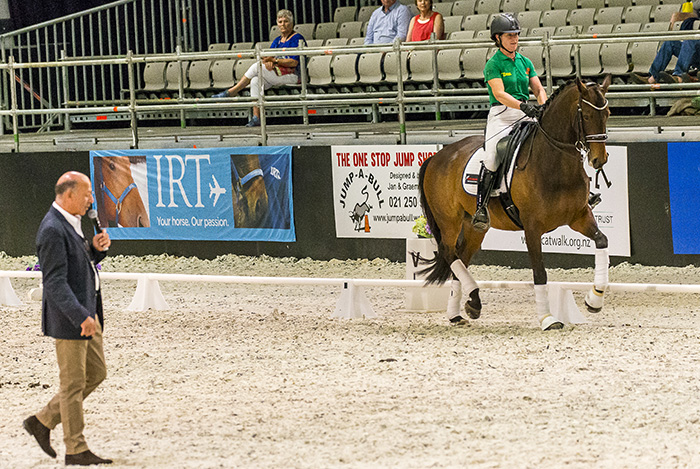
Victoria went into a stretchy trot to release the muscles of the horse’s back and get some of the stress out before a walk break while Jonny continued, “When you collect the horse, you have to bounce it back onto the hindquarter. When you extend, the back gets looser which gives you more possibility to bounce the energy back. This is why the transitions are so helpful.”
Andrea wanted to point out how the whip is used in Jonny’s stable, “We don’t really carry a whip, but when we do, we use it more as an encouragement than a punishment.”
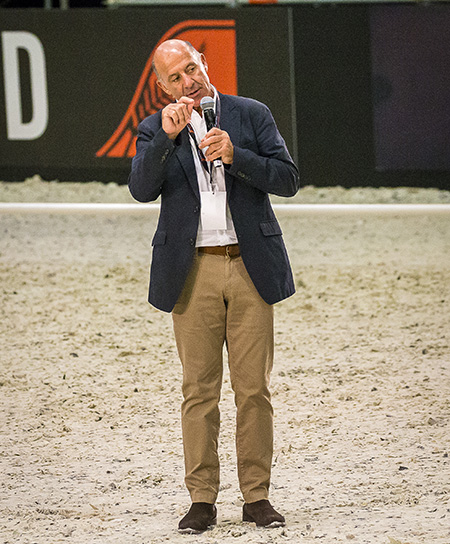
“I use the whip to explain myself to the horse. If a horse is a little laid back, I use the whip over my leg and on the tail and while I walk, I tap, tap, in the rhythm like it’s an extension of my aids. The horse should not be afraid of the whip. The body and mind should not get tight or tense. It is a tool to explain.”
To start the piaffe work, Victoria was asked to walk, do some half steps and then halt. The horse had plenty of energy, but to mould it without holding too much in front took quite some skill, and Jonny wanted to see a softer hand from Victoria, as well as a slight change in her posture, “The horse is hot and sensitive. Victoria has her seat a little bit more forward to ride the mare softer, but that has the side effect that the horse is a little on its shoulder, so Victoria needs to sit a little bit more upright.”
“The tiny problem is just the connection from the back through to the neck. Super. This is different quality now. It is important to communicate with the horse. Tell her it is good because that was a different quality to before. Her whole body got more free. She can hold herself but have enough freedom to produce piaffe. Not more forward. Ja. Super.
“The mouth and the jaw is extremely important because if the mouth is too dead, the whole horse is dead. If the horse is too nervous, the rider’s aids don’t get through. You have to communicate and yield. Don’t sit on your horse and be happy she lifts her legs. Keep the quality.”
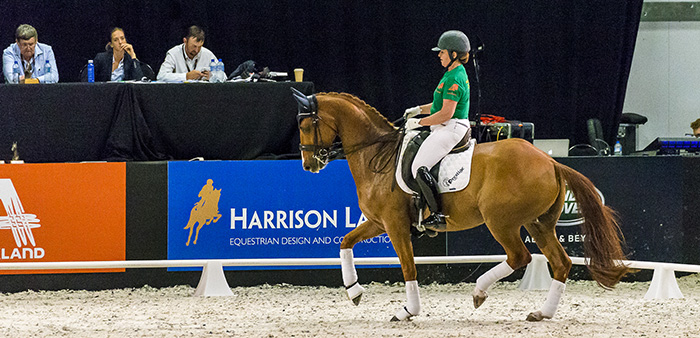
Sheena Ross had her sprightly 10-year-old Parkridge Disco SW in the arena and Jonny acknowledged the hotness of the horse, “You don’t need physical strength to create something. Small details and timing. Timing is crucial with hot horses.”
“This horse is always forward going, but how do we handle that without taking the contact and stopping the horse? Horses cannot have enough expression and enough go, so we have to keep that, but keep it in the tempo control with us. Imagine you sit on a bike and you go downhill and suddenly you have no brakes and to goes faster and faster, so the only way to slow it down is to go uphill. So as a rider, you use the weight of your body. I don’t want them more stressed or short, but I use my seat to bring the horse uphill, until I feel it doesn’t run anymore but it keeps its energy.”
“Sheena also has a little bit of a tendency to lean forward, so we need to sit her back a bit. I saw Sheena a few days ago and already I can see a difference. The horse looks much more relaxed and his canter more elastic.”
In making the corrections in the canter over the past few days, Sheena had slightly lost her ‘tempi buttons’ so Jonny wanted to help her get them back. “Organise the neck more straight forward. It is not easy when the horse is very sensitive. Sometime they don’t react, sometimes they overreact, so you need to find the timing, and make the right decision, more aid or less. You need to drive him up hill a little more, but easy with your seat.” Sheena made the right corrections which improved Disco’s canter, “The quality is better, the stride is longer.
“If you get a problem in the tempis, go back to basics, to getting the canter better. Then you don’t get frustrated. Give yourself time; give your horse time”.
When the pair went into the passage work. “When she let the neck longer and the head out a bit, the back released and there was more elasticity. You need the lightest contact possible. I’m complaining now at a very high level! There was a slight flexion to the left side of his body, which caused a tiny irregularity behind. So, be very picky with the straightness in your seat, and in your horse. Ride the mouth in front of your seat.”
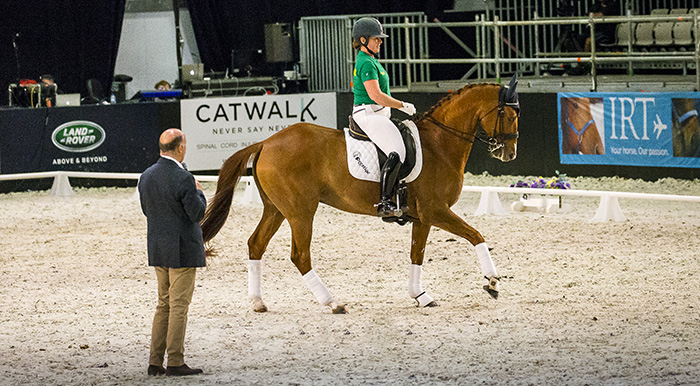
When Disco decided the audience was more interesting than his rider, Jonny asked Sheena to do a couple of transitions to get his concentration back. “Just massage a little with the snaffle and relax his jaw. Keep the horse under your seat. Keep the seat. Exactly. You can see the horse is a tiny bit resistant when Sheena sits on his back because I don’t think he’s used to it, but this is what has to happen, like you sit on his hindquarters. This sort of communication gives you better security. He’ll stay in passage because he stays with your seat. But you train that with your seat, not your hand.”
When it came to the piaffe/passage transitions, Jonny suggested using a long whip back near the horse’s tail. “They are both there, but the transition is not 100% yet.”
Jonny was happy with the end result, “I have to say, the horse has a nice presence. The trot is softer after all the work. He’s not running as much.”
For regularity, to get more energy and more mobility, you guessed it, you have to go back to the basics. “If the contact is tricky in passage, you go back to the trot. It doesn’t show up so much because there is more forward. The more collected, the more the problems are seen.”
Disco was quite energised by all his collected work so Sheena wanted to know the best way to calm him down. Jonny advised, “I release the tension and stretch in rising trot. I release and let them fall apart. Spend time until you feel he gets almost a bit lazy. Even when being stretched, he was being a bit grumpy, so let him go…to the buckle!”
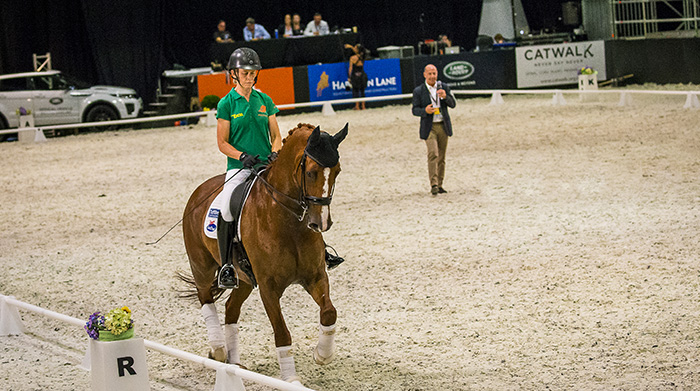
The Masterclass concluded with Wendi Williamson, who travelled to the USA earlier this year to compete in the World Cup Finals. Today she was riding her 10-year-old Don Amour MH. Jonny commented, “ This is a very good example of a top class international project. Not too many weaknesses. This could be very exciting for the future.”
There were still a few little obstacles to overcome. “When you think back to the first horse that came in, with almost an ideal body, Wendi’s horse has a little problem; the neck is set a little low and goes quite straight up. The nose needs to be in front of the vertical and this is not so easy for this one. But that is part of the training that has to be concentrated on.”
While Wendi played with some tempis, Jonny explained how such an energetic and elastic horse required clever riding, “The changes have a lot of energy, a lot of rubber. The seat has to be very concentrated, very steady because the horse will react to light aids. But that is good dressage, riding with your weight and your seat and very small aids.”
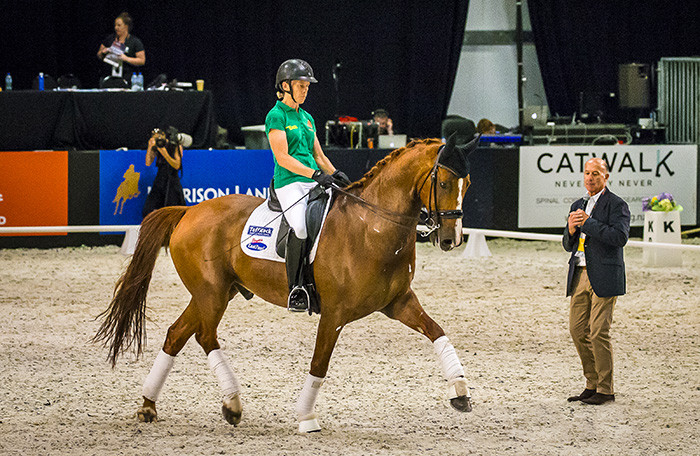
Wendi then rode the centre line with tempis and pirouettes like in Grand Prix Special. She was worried the pirouettes were getting too slow, but Jonny said that Don Amour was a big horse, and it was actually correct, however he wanted to take a closer look at the changes.
“All the changes are secure, but in the one tempis, Wendi was trying to concentrate the energy, so she thought a little bit more backwards. The croup got high, the front end got low. Take your time until the canter is right. 20m circle to get a bit more energy. More forward. Connect yourself a little bit more through the snaffle rather than the curb. Keep the nose and mouth more forward. Don’t be afraid of mistakes. Take your energy more up so it’s easier for you to carry the changes through. Maybe come off the track to get more forward. Now, back to the tempis but don’t take too much of the energy away.”
Wendi had worked through the problem, “Super rhythm. Well done. This is quite a good example of how to handle the little problem Wendi had. We stopped the changes, got the canter more in front of her seat, and in front of himself, and out to the contact so the tendency wasn’t backwards. Don’t get frustrated with the changes, reorganise the canter and the energy of the canter.”
Wendi said that sometimes she overrides her other Grand Prix horse in her worry of fitting in all the movements (isn’t it lovely when riders are confident enough to share their issues so we can all learn?!) Jonny understood exactly where she was coming from, and talked her through the pirouette centreline. “It’s happened to all of us who do Grand Prix. Movement comes after movement, and there’s so little time to correct something, so sometimes it’s hard to catch up again. To get the horse confident, just come onto the centreline and prepare for the pirouette, collect the canter, but don’t pirouette. Sit a little bit more backwards and control the horse’s back. Get the front up and forward. Sit back.”
Wendi gave it a couple of goes, “Sometimes the horse got a little slow so Wendi reacted with more speed, but we want more energy, not faster. Whip to the tail so you can produce a higher frequency.”
“Now, add the pirouette, but not a small, competition pirouette.” Jonny told the crowd, “The horse got a bit slow because he got overbent. The outside hind leg has to hold the horse for awhile so the distance across the diagonal, from outside hind leg to inside shoulder gets longer, so the horse gets slower. Produce energy with your back.”
“It’s all about power, and that sometimes can feel scary; they feel like they can take off. But stay calm and cool and almost look at yourself and the horse from a distance. Don’t get too emotional and too mentally involved. You need to coolly analyse.”
The final discussion was about passage and piaffe, but Jonny started with an extended trot first to energise and refresh the horse. “Good. There was no rhythm change. Now piaffe and passage, but make sure to give him enough neck.” Wendi complied, and it was a good note on which to finish.
Jonny’s conclusion: “Sometimes we have horses in the stable that we know can do these Grand Prix movements, but we haven’t found the way to get their body. Always go back and use the basics.”
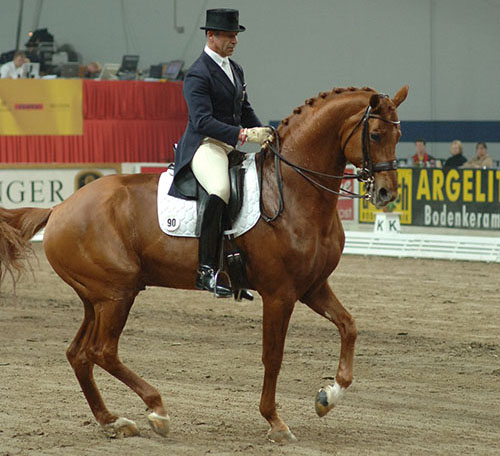


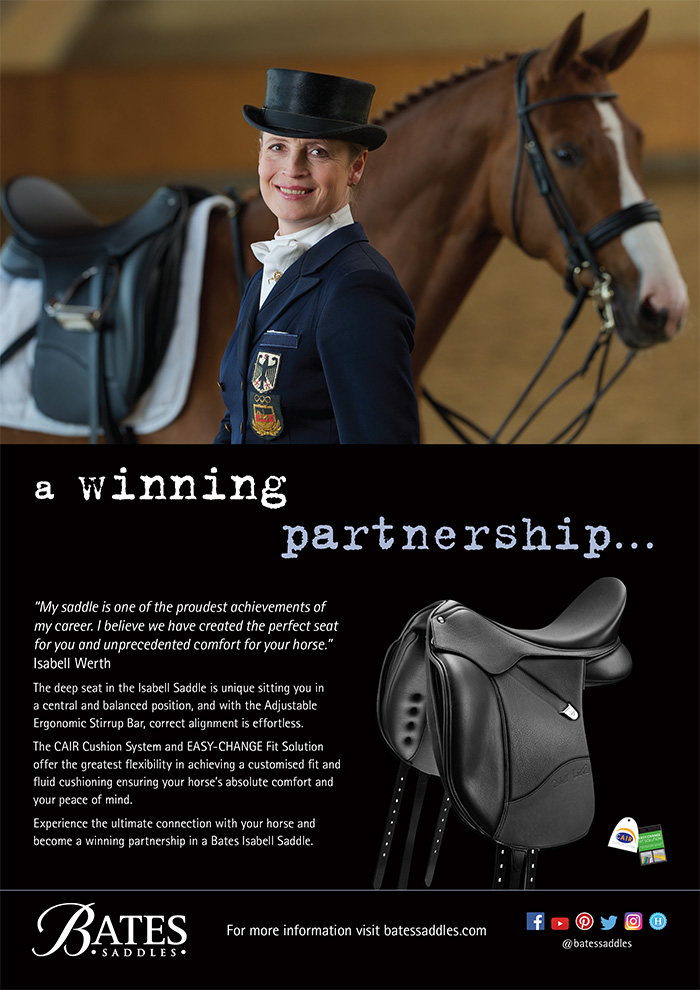
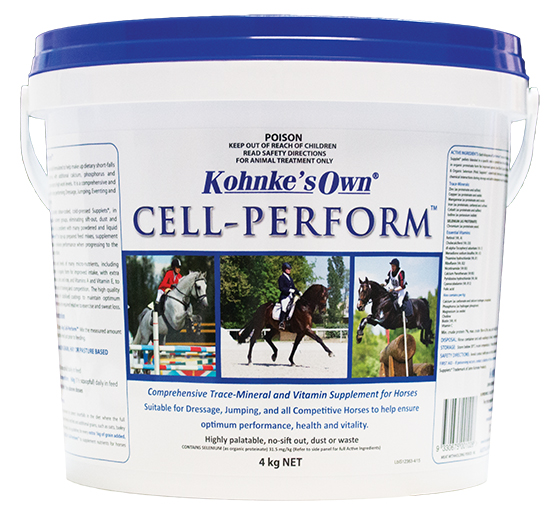
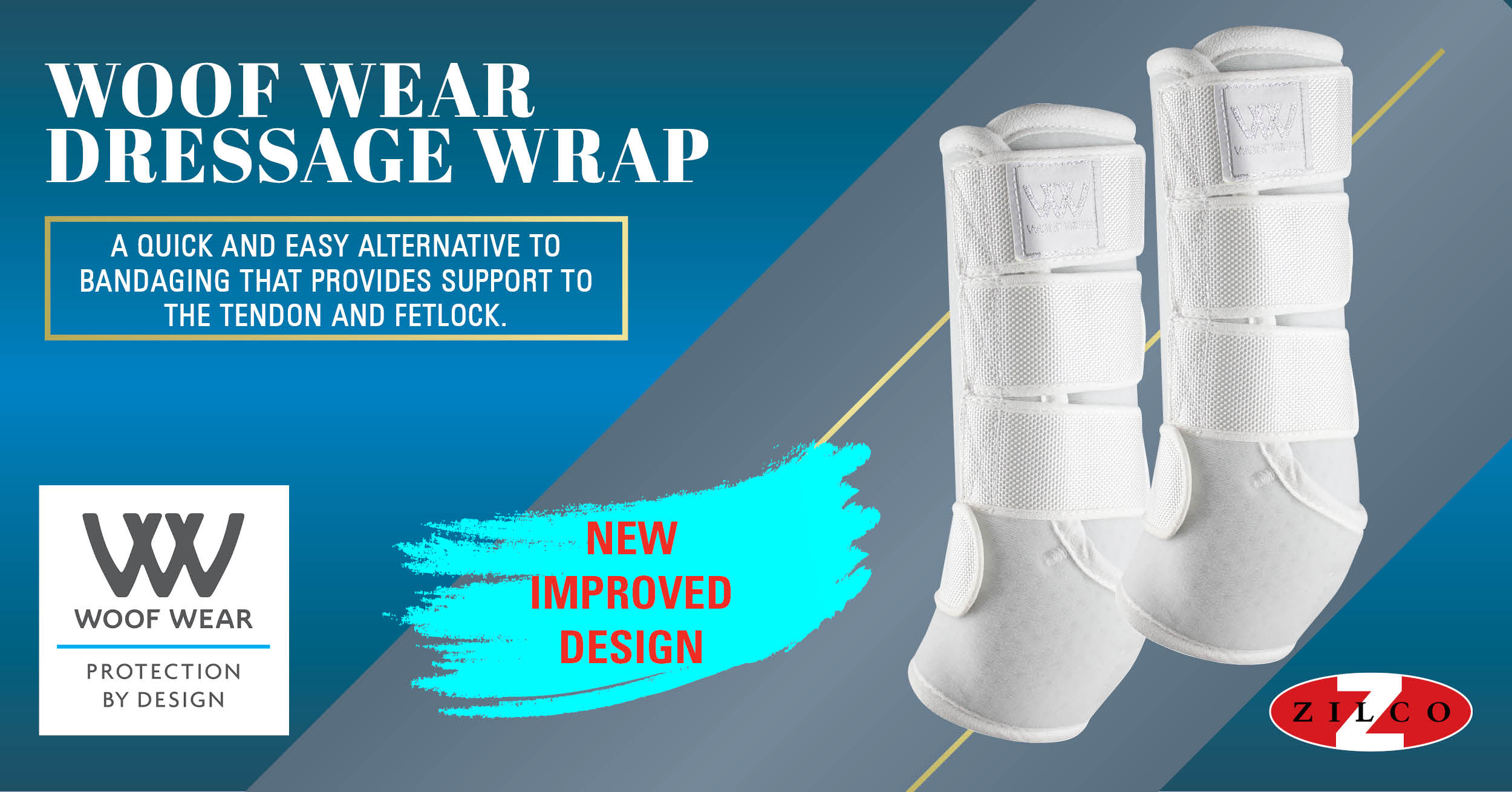
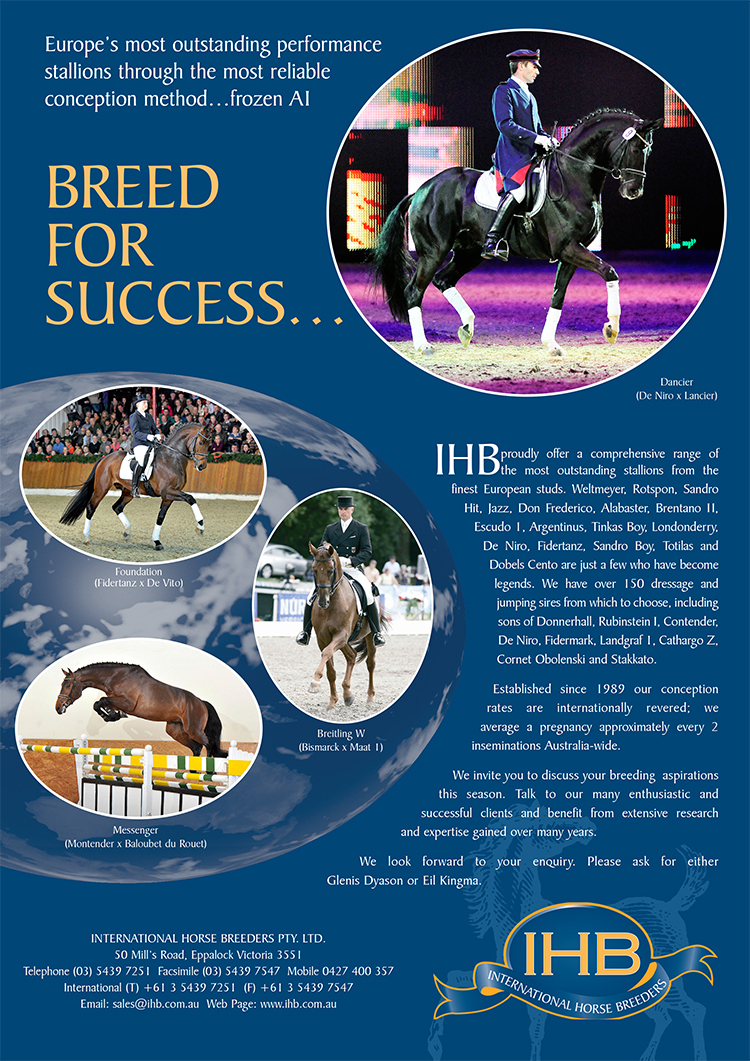
Brilliant !!!!!!